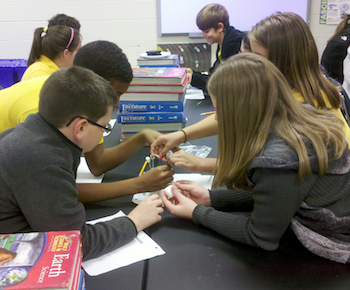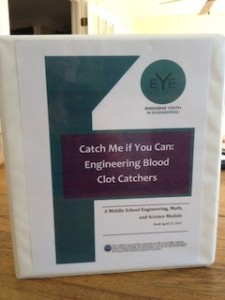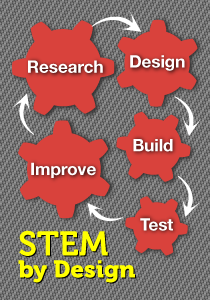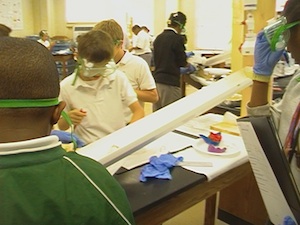7 Secrets of STEM Success
A MIddleWeb Blog
I’m hoping you didn’t click on this post hoping to find a quick recipe for a STEM program. Although successful STEM is doable – in fact essential – it will require you to roll up your sleeves. STEM is not a prescription. STEM is not an education fad. You’re going to need plenty of determination, persistence, and patience. You must be willing to experiment, analyze, and change things that don’t produce the results you want.
You’ve heard this refrain repeatedly because it’s true: STEM is the doorway for our students into a powerful 21st Century workforce. It’s definitely worth the effort. So what are some ideas for developing a successful STEM program?
The good news is that I can offer an example of a successful systemwide STEM program that continues to evolve, change, and grow. I’ll share some secrets and a solid to-do list, based on the aha’s and lessons learned by this program’s creators. And I think these same insights can be applied (with some modification) to a single school and can even be useful to a single teacher.
The story I’m about to tell is certainly not the only STEM success story out there. If you have one of your own – classroom, schoolwide, or systemwide – I invite you to tell us about it in the Comments section.
A strategic STEM partnership

The background: One of MAEF’s largest current initiatives is a program called Engaging Youth through Engineering (EYE) – the brainchild of Dr. Susan Pruet, who began her career as a middle grades mathematics teacher. Area business and industry leaders asked MAEF/MCPSS to develop EYE to help prepare a highly skilled, engineering-oriented regional workforce, and they provided seed funding for the first three years of the effort.
7 secrets of a strong STEM program
If Dr. Pruet wrote an advice column about STEM program development, it would probably include these seven points:
1. Know why you want STEM in your school system. Happily for me (a former middle school science teacher), this EYE program focuses on students in grades 6-8. Why middle school? The goal is to encourage students to choose and be successful in challenging high school coursework — the kind needed to become knowledgeable, technology-savvy workers for major industries located in Mobile, including aerospace and shipbuilding. Notice how specific that purpose is? EYE is not preparing students for a hypothetical workforce. It’s for preparing them for a local workforce. Of course, this high school preparation also prepares students to be successful in challenging STEM coursework in college.
2. Get information about successful STEM programs. The first step Dr. Pruet took was to put together an EYE planning team that included all stakeholders – business leaders, teachers, and administrators. The team investigated STEM programs, made onsite visits, and then adopted Engineering is Elementary as a pre-STEM starting point for involving elementary school students in thinking like engineers. In the early years, EYE experimented with STEM lessons in several middle schools and gained important perspectives on the professional development needs of science and math teachers.

4. Start small: then test, revise, and evaluate before scaling up. Working inside a system with 19 middle schools, each EYE module has been piloted in two middle schools and then field-tested in three representative middle schools. The number of module revisions has been mind-boggling – from totally throwing out a whole module and starting again, to making substantive changes to the piloted module. (No module ever worked as intended the first time.) Once the impact of the modules is externally evaluated and shown to be successful in improving student outcomes, the scale-up process begins. That leads to the next point.
5. Make STEM curriculum doable and affordable. The EYE modules include self-explanatory lesson plans, detailed instructions for teachers, and copies of all materials that need to be reproduced. Equipment and materials for hands-on implementation are relatively inexpensive. This helps to ensure successful replication.
6. Provide professional development and ongoing support for teachers. This is probably the key to ensuring sustained, successful implementation of STEM in schools and classrooms. In a recent blog post I mentioned that most teachers are not adequately prepared and equipped to teach STEM. This is a relatively new adventure. I suggested several possibilities there, but two key elements, from my standpoint, are these:
• Provide intensive training on teaching the particular STEM lesson/module upfront. This may take a couple of days, as you want to clearly lay out the rationale, the “how to” process, and the pay-off for students.
• Set up cross-curricular teacher teams. Then provide time during the school day for these teachers to work together to implement, assess, adapt, and even build new STEM lessons. In other words, build a process by which teachers can support one another and hold each other accountable for results.
7. Keep STEM education on the front burner. STEM attacks a deeply ingrained, status-quo way of teaching and learning. We must keep STEM front and center. Fortunately, both the Common Core Standards for Mathematics and the Next Generation Science Standards are a great fit for STEM, so a perfect storm is building that can finally get us over the status quo hump. That’s going to take persistent effort on all our parts, though.
 Helpful links: Building a STEM program
Helpful links: Building a STEM program
8 Keys to Success with STEM. This blog post by Diana Layboy-Rush actually provides the first 4 Keys to successful STEM implementation. Diana’s blog is a good one to follow for STEM ideas.
Roadmap for Success in K-12 STEM Education. This article from Science Daily offers good information and other links to improving STEM education.
Successful K-12 STEM Education: Identifying Effective Approaches in Science, Technology, Engineering, and Mathematics. Although I mentioned this in my last post, it bears referencing again. This free-for-download publication from the National Academies Press lays out some clear pathways schools and districts can follow to build successful STEM programs
I hope these ideas help you strengthen your own commitment to developing a strong STEM program in your school or district. If you have thoughts about anything I’ve shared here, please leave a comment!

































Now that’s an amazing piece of write up for understanding the importance of Program for high school students. The points that have been mentioned here will surely help the young lads to start their journey with Summer Programs. Someone has suggested for my younger sibling and this article helped me in narrowing down my research Program Schools. I would really like to Thank You for putting in the efforts. Keep up the good work guys! :)
Thank you for your response, Brian. It helps to know what kind of articles are helpful to readers!